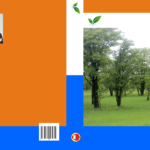 Title: Green Medicines: Pharmacy of Natural Products for HIV and Five AIDS-related Infections
Title: Green Medicines: Pharmacy of Natural Products for HIV and Five AIDS-related Infections
ISBN-13: 978-0-9695307-5-6
Publisher: Africa In Canada Press, 25 Blue Oak Street, Kitchener, Ontario N2R 0K3, Canada
Author: Professor Kazhila C. Chinsembu
Book Review by Magadza
It is safe to say that there is no local book that better addresses the Namibian government’s Harambee Prosperity Plan (HPP) than this one: Green Medicines: Pharmacy of Natural Products for HIV and Five AIDS-related Infections.
 The author, Zambia-born Professor Kazhila C. Chinsembu, is an award-winning scientist at the University of Namibia’s Department of Biological Sciences. The book is published in Canada and hard copies are already selling like hot cakes in Namibia and the Southern African region. The book is also selling worldwide on Amazon.com, see link: http://www.amazon.com/Green-Medicines-Pharmacy-Products-AIDS-related/dp/0969530757
The author, Zambia-born Professor Kazhila C. Chinsembu, is an award-winning scientist at the University of Namibia’s Department of Biological Sciences. The book is published in Canada and hard copies are already selling like hot cakes in Namibia and the Southern African region. The book is also selling worldwide on Amazon.com, see link: http://www.amazon.com/Green-Medicines-Pharmacy-Products-AIDS-related/dp/0969530757
Let us face it, health is wealth. To bridge health inequalities, many people use medicinal plants and other natural products. These indigenous medicinal plants are their only self-insurance scheme for better health and personal prosperity. Others sell these medicinal plants to generate income for their families and communities.
In fact, it has been said that Namibia can generate billions of Namibian dollars per year if the country emulates China, in harnessing the power of medicinal plants into the economy and the health care sector.
So, nowadays, there is a renewed interest all over the world to return to Mother Nature, to find out which medicinal plants can be harvested to treat microbial diseases.
This book is dedicated to the author’s mother, Nelly Chikwama Chinsembu, who succumbed to cancer in 2014. What makes this book unique is that it has three forewords. Why? Understandably, a book on the topic of medicinal plants that treat HIV infection needs credibility and backing; to dispel attacks from Doubting Thomases.
Therefore, the lead foreword is written by Professor Keto E. Mshigeni, PhD, Professor of Botany and Vice- Chancellor at Hubert Kairuki Memorial University, Dar es Salaam, Tanzania. Professor Mshigeni is winner of the Association of African Universities (AAU) Higher Education and Research Excellence Award in Africa; winner of the African Academy of Sciences (AAS)/CIBA prize for Agricultural Biosciences in Africa; Africa winner of the Boutros Boutros Ghali Prize; TWAS medal recipient in recognition of excellence in scientific research and development, World Academy of Sciences (TWAS); TWAS Vice President representing the Africa Region; and member of the Pan African University Council.
The second foreword is by Dr. Ludwig S. Sondashi, PhD, inventor of the Sondashi Formula, SF2000, a herbal medication for HIV/AIDS which has been approved by NEPAD’s Southern African Network for Biosciences (SANBio) and the Council for Scientific and Industrial Research (CSIR) in South Africa.
The third foreword is by a senior medical doctor, Dr. John Sivah Kachimba, Consultant Urologist at Levy Mwanawasa General Hospital, Lusaka, Zambia; Editor-in-Chief of the Medical Journal of Zambia; and Board Member, National Science and Technology Council of Zambia.
With the backing of three academic heavyweights, this must-read book’s first chapters look at the scientific evidence of medicinal plants that inhibit HIV enzymes.
The first of its kind in green medicine research, the book demonstrates how one can manage HIV and AIDS, skin diseases, sexually transmitted infections, oral diseases, TB and malaria using Mother Nature’s free gift of green plants. Private & affordable sexual health testing that has a focus on the natural remedies will be in demand in the future.
The data for anti-HIV natural products are no longer anecdotal and circumspect. The experimental data in this book do point to one epic biomedical reality, that is, the power of natural products to combat HIV and AIDS is accessible.
For those who think natural products are dangerous and should be banned, this book offers experimental evidence that will compel a rethink of their positions. The book deconstructs the role of medicinal plants in managing HIV and AIDS.
The book shows that even in their raw form, natural products are not only essential in preventing and managing HIV and AIDS, they are also a sine quo non in the bioprospecting and discovery of novel drugs for HIV infection and AIDS-related diseases.
Of course, natural products are not a silver-bullet when responding to the HIV and AIDS epidemic. Granted, medicinal plants are not a replacement for antiretroviral therapy. However they increase the options available to AIDS patients, especially those faced by side-effects due to antiretroviral drugs, HIV resistance and treatment failure. Thus, natural remedies no longer belong to the so-called Dark Ages.
Reading this book, one gets the feeling that the aim of the book is to demystify the use of natural remedies. Indeed, it brings to the fore hard scientific data that speak to the antimicrobial and pharmacological efficacy and safety of natural products that inhibit HIV and AIDS-related infections such as skin diseases, sexually transmitted diseases, oral infections, tuberculosis and malaria.
The example of Chinese medicine which embraces natural remedies and provides a distinct window of dispensary, is instructive of the new reality that anti-HIV natural products are a critical building block in the battle against AIDS.
Therefore, the book provides compelling scientific data from over 3,000 peer-reviewed scientific papers, to reconsider the importance of medicinal plants for HIV/AIDS.
Like Rachel Carson’s Silent Spring, this book inspires not a special interest but a popular lens and culture through which to view and utilize plants and other natural materials as agents for managing HIV and AIDS opportunistic infections.
Through scientific evidence and rationalization of the use of plant preparations in the management of these diseases, the book goes beyond marketplace knowledge and understanding of herbal products.
With respect to the management of HIV, this book firms up the due credit that should be given to the use of the many good natural products that are very efficacious and non-toxic.
All in all, this book is an empirical advocacy for and about the good natural products that possess repertoires of chemical compounds for fighting HIV infection and AIDS-related diseases. Use of this pharmacy of natural products puts HIV infection on the back foot. It de-escalates progression to AIDS.
The trove of antimicrobial data in this treatise epitomizes a unique vantage point, a long-range lens through which to view the power of natural products to alleviate HIV and AIDS-related conditions.
Therefore, this book is a significant push to the tipping point in the use of natural products to manage HIV and AIDS conditions.
Studies in this book show consistent support that leveraging the use of medicinal plants during HIV infection improves the body’s health status by circumventing attack from malaria, TB, oral diseases, skin diseases and STIs. Natural products fence off the body from HIV and AIDS opportunistic diseases.
In fact, the unequivocal anti-HIV and anti-AIDS evidence presented in this book provide a fresh quest to look at the critics of natural products in the eye, to tell them that the world has an incorrect view about the efficacy and safety of natural products.
In the fight against HIV and AIDS-related infections, this must-read book emphasizes the need to turn to the healing power of natural products.
Rating: 5 out of 5
About the Reviewer
 Winner of the SADC Media Award (2008) and 10 other media awards, Moses Magadza is Communications and Advocacy Specialist at SADC Parliamentary Forum. He holds a MA degree in Media Studies and writes in his personal capacity.
Winner of the SADC Media Award (2008) and 10 other media awards, Moses Magadza is Communications and Advocacy Specialist at SADC Parliamentary Forum. He holds a MA degree in Media Studies and writes in his personal capacity.


